Jean-Philippe Rameau’s Dardanus is the first time ETO have tackled
the French baroque. The opera got caught up in its own war: the war of
words that raged during the 1730s between the Lullistes, who
posited themselves as the defenders of French musical traditions, and the Ramistes, who supported Rameau’s innovative introduction
of dissonance, colour and virtuosity. The premiere in 1739 ran for 26
performances, but the libretto by Charles-Antoine Le Clerc de La BruËre was
criticized for its absurdities and supernatural elements, and the composer
and Pierre-Joseph Pellegrin subsequently carried out extension revisions,
excising the mythological prologue, the dream sequences and sea monsters,
focusing on the human elements of the tale, and entirely re-shaping the
last three acts. The new version was given in 1744 and it is this score
which ETO are presenting, incorporating some of Rameau’s further 1760
revisions.
Dardanus
is a treatment of the legend of the eponymous founder of Troy. The plot is
a simple one. The Phrygian King Teucer wants his daughter Iphise to marry
his ally, AntÈnor, but she has fallen in love with her father’s enemy,
Dardanus. IsmÈnor, who was a priest to Dardanus’s father Jupiter, agrees to
help when Dardanus reveals his love for Iphise, and when the latter arrives
to solicit advice, Dardanus disguises himself as the soothsayer. Though
delighted to learn her passion is returned, Iphise is torn between love and
duty. Dardanus is defeated in battle and imprisoned, but Venus takes pity
on the captive and frees him, just as a sea monster attacks Teucer’s
kingdom. Dardanus succeeds where ArtÈnor fails and, incognito, slays the
monster: asked by ArtÈnor to name his reward, the disguised saviour
requests permission to ask for Iphise’s hand in marriage. Learning of
Dardanus’ identity, ArtÈnor wavers and Venus again intervenes, persuading
Teucer to agree to the marriage.
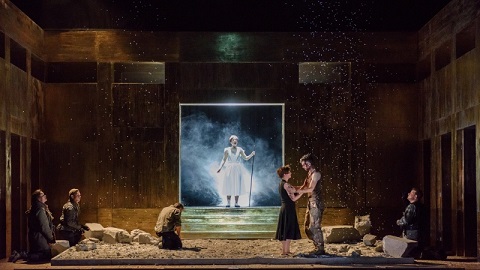 ETO – Dardanus. Photo credit: Jane Hobson.
ETO – Dardanus. Photo credit: Jane Hobson.
Designer Cordelia Chisholm’s dimly lit, dirt-streaked sandstone bunker
evokes the ravaged landscape of a contemporary Middle Eastern war zone.
Within the three towering walls which frame the sides and rear, a grey
ash-pit dominates the stage floor. Gliding panels allow for the imperious
entrances of the war-mongers, down the central steps at the rear; coloured
light (Mark Howland) flickers through windows aloft indicating the fire of
battle. The windows slide shut when Dardanus is incarcerated in Act 4,
though a ladder offers a means of escape.
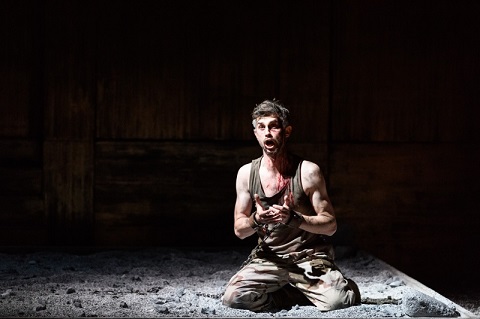 Anthony Gregory (Dardanus). Photo credit: Jane Hobson.
Anthony Gregory (Dardanus). Photo credit: Jane Hobson.
During the overture, military personnel in modern-day fatigues and helmets
turn the ash pit into a grave for eight dead soldiers, the memorial stones
formed from relics of war and soothed by flickering candles. The visual
image created by director Douglas Rintoul is slightly at odds with the
jaunty, sparky oboe playing and lithe rhythms that we hear, but it’s a
focused one. The problem with this sand-pit, though, is that it’s just too
big, forcing the cast to the margins, restricting movement – any essay at
the dance that is so central to Rameau’s idiom would be limited to a
tip-toe foray – and eradicating the very union of the expression of the
body and the expression of the score which is essential to this operatic
aesthetic.
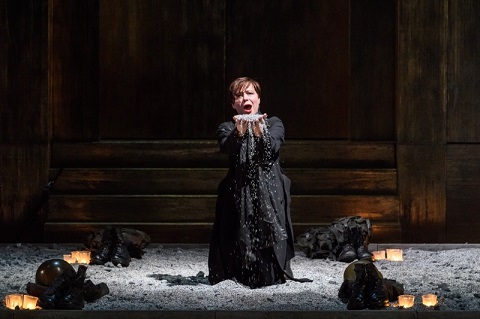 Galina Averina (Iphise). Photo credit: Jane Hobson.
Galina Averina (Iphise). Photo credit: Jane Hobson.
Fortunately, there is much fine singing to enjoy. As Iphise, Russian
soprano Galina Averina displayed the crystalline brightness that I admired
at last year’s
London Handel Festival
. Although she was a little under-powered in Iphise’s first aria, in which
she pleads with Cupid to cease tormenting her heart, Averina quickly
adjusted to the acoustic in the full Hackney Empire and Act 3 opened with a
much more stirring monologue. Averina displayed an acute sense of Rameau’s
phrasing, colouring the text beautifully to convey Iphise’s emotional
suffering and bringing roundness to a character who is in fact rather
passive.
Anthony Gregory’s Dardanus is even more powerfully communicative: his tenor
is both focused and flexible. Gregory has strong stage presence and knows
how to pin moments of dramatic intensity. His honeyed warmth grew in
fullness, climaxing in Dardanus’s Act 4 prison monologue, ‘Lieux funestes’,
in which the careful apportioning of emphasis, ornament and expressive
swell was both impressive and deeply moving.
Grant Doyle seems to be making a habit of playing authoritarian patriarchs
of late
(see review, Mansfield Park)
, and the baritone was an imposing Teucer, immediately establishing his
no-nonsense command in Act 1 when the King and AntÈnor pledge allegiance.
The Act 4 confrontation between Teucer, Iphise and Dardanus, in which the
latter offers to sacrifice himself was one of the dramatic highlights of
the production, and Doyle conveyed all of Teucer’s inner conflict when he
learns of his daughter’s love for his enemy.
Bass-baritone Frederick Long was equally well-defined as the magician,
IsmÈnor, establishing his occult power compellingly in Act 2, and in the
small role of Arcas, AntÈnor’s supporter, tenor Alessandro Fisher was
characteristically dramatically convincing and vocally reliable. Only
baritone Timothy Nelson, as AntÈnor himself, seemed a little out of sorts.
He struggled to tune the higher vocal lines and the phrases lacked
persuasiveness, seeming to ‘wander’ without a sure sense of destination,
lacking confident feeling for the declamatory veracity of the melodic
shapes.
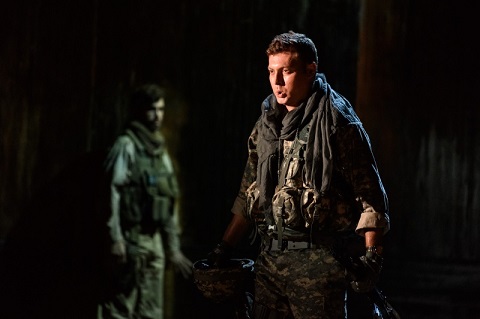 Timothy Nelson (AntÈnor). Photo credit: Jane Hobson.
Timothy Nelson (AntÈnor). Photo credit: Jane Hobson.
In musical and dramatic terms, the small chorus would have benefited from
enhanced numbers; but, though they came momentarily adrift in the first two
ensembles, they thereafter settled into an effective unit. Similarly,
though they were a little ragged at times and generally the instrumental
phrasing was in need of greater flexibility, under conductor Jonathan
Williams The Old Street Band produced some fine musical moments: dashing
strings were matched by soothing flutes and expressive bassoon playing
darkened the miseries of the prison scene still further.
Rameau’s sparkling and varied instrumental dances grew in assuredness and
spirit, culminating in a final dance around the ash-pit – which was now
transformed into a memorial to an unknown soldier or, perhaps, to the grave
of War itself – in which soldiers, freed at last from conflict, snatched
Cupid’s wings, played kiss-chase and raced around in a supermarket trolley.
The irony felt a bit of a jolt after the staid steadiness of the drama:
only the arrival of Eleanor Penfold’s white-winged Venus had served as a
reminder for the strata of humour which is embedded in the opera. Perhaps
the production would have been vivified if such drollery had been more
consistently integrated and sustained? But at least we were spared
gimmicks. In the event, beautiful though the singing, it did not generate a
lot of dramatic momentum, but Rameau’s score – of striking richness,
variety and strength of character – packed its punch.
Handel’s Giulio Cesare the following day offered a sharper
dramatic edge. Indeed, there were plentiful knife-blades in James Conway’s
production: from the dagger with which Cleopatra slices off a general’s
buttons and nicks her own lip to relish the taste of blood, to Achilla’s
blade of assassination which haplessly slashes the air, narrowly missing
Cesare’s back; from the hand-knife which Sesto uses to draw blood from his
own arm and thus courage and purpose from his heart, to the flashing sword
which the unyielding Caesar swirls with the panache of a musketeer.
The glints of steel establish a cruel air, and are complemented by the
glimmer of gilt that Mark Howland’s lighting conjures from the high walls,
transforming the cold, damaged stone of Dardanus’ prison into the gleaming
marble of a Roman citadel. Chisholm replaces the ash-pit with a smaller
stone dais which draws the eye to the heart of the opera’s seditious
intrigues. Sliding panels now retreat, suggestive of the majestic portals
and porticos of an imperial city. The splendid costumes set the action in
Handel’s eighteenth century while a fabric and light palette of gold and
Egyptian blue evokes the historic past.
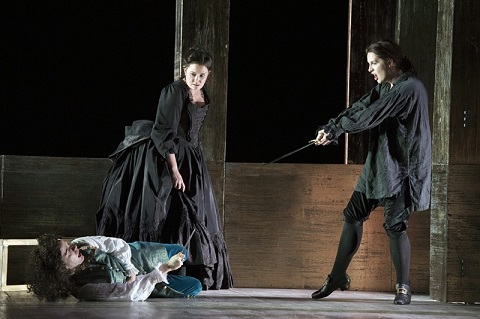 Benjamin Williamson (Tolomeo), Catherine Corby (Cornelia) and Kitty Whately (Sesto). Photo credit: Richard Hubert Smith.
Benjamin Williamson (Tolomeo), Catherine Corby (Cornelia) and Kitty Whately (Sesto). Photo credit: Richard Hubert Smith.
James Conway’s production defines the characters keenly and choreographs
the conspiracies with skill. It avoids theatrical excess and the paring
down of the visual elements shifts the focus from the external action to
the internal dramas. However – to get the gripe out of the way at the start
– it’s too long. Declaring that he wishes to ‘present Handel’s work
absolutely uncut’ and fears that ‘4 hours would not wash’ with audiences,
Conway gives us 5 hours instead.
The action is divided into two parts: on tour they will presented both
consecutively on a single day (as I experienced), and on successive
evenings. The first part, ‘The Death of Pompey’, takes us from Caesar’s
defeat of Pompey and his reconciliation with the latter’s wife Cornelia and
her son Sextus, through the decapitation of Pompey by Achilla at the orders
of Tolomeo, and his sister Cleopatra’s ruse to disguise herself as the
chaste ‘Lydia’ in order to seduce Caesar in a bid to be sole ruler of
Egypt. There follows the boy-King Tolomeo’s imprisonment of the vengeful
Sesto and his (and Achilla’s) futile attempts to woo Cornelia, and the
first part culminates with the arrival of a group of conspirators demanding
Caesar’s death and Cleopatra’s revelation of her true identity and love for
Caesar.
For the second part, ‘Cleopatra’s Needle’, Conway shifts into reverse gear,
takes us back to the third scene of Act 2 in which Achilla pleads for
Cornelia’s heart, and re-runs the action that we’ve already seen, before
completing the tale with Caesar’s presumed death by drowning, Sesto’s
attempts to murder Tolomeo and Cleopatra’s attempts to depose her brother
with the help of Achilla who switches allegiances. At the close Cesare
reappears, rescues Cornelia and Cleopatra and is crowned, with Cleopatra as
his ‘tributary queen’.
Conway explains that ‘to fashion two nights of one opera […] we have chosen
to overlap – with variation – some of the content. It meant we could look
at the opera’s central scenes from subtly different perspectives’. Well,
these different perspectives certainly are ‘subtle’ as I couldn’t detect
any ‘variation’ other than some open wall panels and the omission of
several da capo repeats, thus depriving those who attend only the second
part of some glorious music and fine singing.
Moreover, despite the best efforts of the cast, the persuasively crafted
development of character and dramatic momentum which Conway and conductor
Jonathan Peter Kenny created through Part 1 was dissipated with the
resumption and repetition. It’s difficult to tell if my own disenchantment
was responsible for the impression that singers too were a little weary
second time around, but if they were, who could blame them? Five hours of
Handel is a cruelly long sing, and not all of Handel’s score avoids
note-spinning.
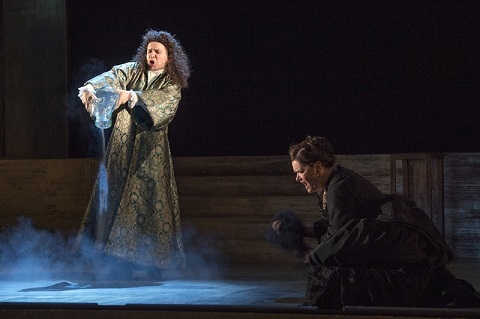 Benjamin Williamson (Tolomeo) and Catherine Corby (Cornelia). Photo credit: Richard Hubert Smith.
Benjamin Williamson (Tolomeo) and Catherine Corby (Cornelia). Photo credit: Richard Hubert Smith.
Those joining the action part-way through must have struggled to understand
some of what are, in fact, Conway’s and Chisholm’s most creative motifs;
wondering, for example, just what was the grey ash in the glass urn that
Tolomeo viciously scattered and stamped on before the distraught Cornelia
(Pompey’s blooded glass head having morphed into a funeral urn in Part 1).
And, who were the clumsy oaf and the black-frocked mourner he so clumsily
attempted to ‘seduce’? Why was Cleopatra wearing and clutching a blue
velvet drape (a relic of the revelation of her love for Caesar, when she is
dressed as the virginal Lydia – see below). Surtitles during the overture
had offered some backstory: ‘Previously …’ raised a chuckle initially, but
I doubt the good humour lasted when they were halted before the recap had
been concluded, as the end of the overture had been reached.
[In fact, the surtitling needs attention before the tour commences, having
gone astray on both evenings. The scene-preface summaries in Giulio Cesare are neat, but too often the recitative surtitles
present asides before they are spoken, thereby undermining the irony, while
the Rameau titles lagged behind the action and malfunctioned at one point.]
‘Late-comers’ also miss out on some terrific coup de thÈ‚tre, not
least the revelation of ‘Lydia’ for Cesare’s delectation: a Renaissance
Madonna, posing gracefully within a golden niche, the epitome of idealised
beauty and tenderness – a deliciously ironic disguise for the devious,
scheming queen, whose head-dress now glowed like an angelic halo. The
iconography may be anachronistic but it’s superb theatre. The droll
summoning of the choral entry from the dress-circle by Frederick Long’s
smug Curio in the opening scene is complemented first time through by a
vibrant burst of song and light as Cesare prepares for battle in Act 2, but
the latter is omitted from the reprise.
There is also some skilful choreography in the opening Act which, for once,
does not detract from but complements and enhances the sung arias. As Sesto
vows to avenge his father’s murder, Cleopatra’s counsellor, Nireno, flicks
a knife with cruel nonchalance in the sacred urn. Cesare’s return for once
last glimpse at the noble Lydia who has entranced him, is perfectly timed
to coincide with Cleopatra’s da capo: she hastily tries to reassemble the
disguise which she has begun to let slip. The attempted assassination scene
is superb, revealing all of Tolomeo’s inexperience and ineptness: Caesar
tips the poisoned wine into Tolomeo’s own glass, and evades the swipe of
Achilla’s blade, with perfecting timing and mocking insouciance.
Thankfully, once again the ETO cast is uniformly outstanding. Soraya Mafi’s
crystalline soprano casts a golden glow over the stage and she has the
stamina to sustain the brilliance and sheen through every one of
Cleopatra’s seven arias. Mafi is every inch the confident and calculating
strategist: unlike the passive Iphise, she doesn’t rely on the men to sort
things out but takes control, believing and showing how a woman’s beauty
and allure can bring her power. In her first aria ‘Non disperar’, she
taunts Tolomeo with dismissive disdain, and her amoral irreverence wins our
admiration against our better judgement. Then, struck, to her surprise, by
genuine love for Caesar, Mafi imbues ‘Se piet‡ di me non senti’ with
heart-aching depth and colour which break through the queen’s supercilious
faÁade and reveals her emotional fragility. The despairing phrases of
‘PiangerÚ la sorte mia’ seem to bear the weight of the throb of suffering;
this Cleopatra is a convincing ally, unwavering in her loyalty throughout
her imprisonment.
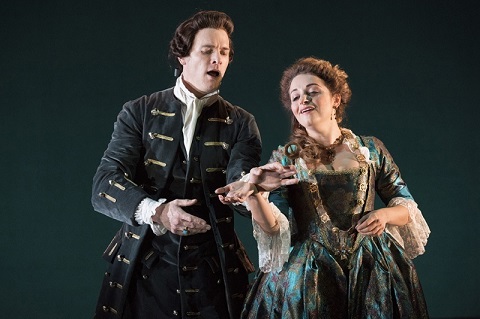 Christopher Ainslie (Cesare) and Soraya Mafi (Cleopatra). Photo credit: Richard Hubert Smith.
Christopher Ainslie (Cesare) and Soraya Mafi (Cleopatra). Photo credit: Richard Hubert Smith.
This is the best performance I’ve seen from Christopher Ainslie, whose
Cesare is by turns a man of noble command, trusting integrity and poignant
compassion. I have sometimes found Ainslie’s countertenor rather
character-lite but here he found range and weight. ‘Va tacito e nascosto’
was an authoritative put-down to Tolomeo, aided by a superb horn
contribution which added the necessary touch of heroic colour. The contrast
with Act 3’s ‘Aure, deh, per pieta’ in which Cesare recognises his own
mortality and humility made a striking impact, as Ainslie crafted a
beautiful legato line, the purity of tone serving to emphasise both
Cesare’s loneliness and his honesty.
Benjamin Williamson’s Tolomeo is no one-dimensional villain but a
convincingly querulous boy-King, indiscrete and injudicious, perpetually
frustrated in his attempts to assert his power and fulfil his sexual
desires. In the contemporary political climate, we don’t need to be
reminded that fools can be dangerous. Williamson’s keenly focused,
bright-edged countertenor captured Tolomeo’s petulance while the sweetness
of tone hinted at finer qualities and emotions struggling to break through
the yoke of immaturity. As Achilla, Benjamin Bevan’s glossy baritone took
on a dark unctuousness at the bottom, as he attempted to seduce Cornelia
with bullying menace in Act 1’s ‘Tu sei il cor di questo core’, brilliantly
complemented by the nasal bassoons in unison with the voice. Thomas
Scott-Cowell’s Nireno lurks and sneaks with Iago-like creepiness.
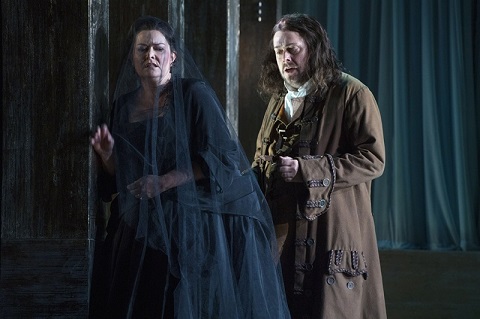 Catherine Corby (Cornelia) and Benjamin Bevan (Achilla). Photo credit: Richard Hubert Smith.
Catherine Corby (Cornelia) and Benjamin Bevan (Achilla). Photo credit: Richard Hubert Smith.
Initially Catherine Carby had a little too much vibrato and portamento for
the purists, but her Cornelia grew in stature and dignity, her bronzed
mezzo laden with the dark hues and sorrowful burden of grief. The depth of
the bond between mother and son was beautifully conveyed in ‘Cessa omai di
sospirare’, as Carby and Kitty Whately’s Sesto scheme anew to kill Tolomeo.
Whately’s mezzo was wonderfully clean in ‘Cara speme, questo core’, Sesto’s
response to the first murderous plot against Tolomeo, and as gracefully
sculpted as the elegant obbligato cello. Whately communicated Sesto’s
growing resolve and maturity, and sailed through the sequence of revenge
arias using the vocal virtuosities to reveal not merely stereotypical rage
but also real human suffering. ‘L’angue offeso mai riposa’ was invigorated
by moral conviction although I thought that Jonathan Peter Kenny was
pushing the tempo just a whisker too fast for Whately, who struggled to
keep up with the bass’s racing quavers; second time around, things were a
tad more settled.
At the final reckoning, although Conway’s decision to reprise the second
act might leave some punters feeling short-changed and seems to undermine
his aim to avoid cuts in order to present Handel’s opera so that the
‘proportions would be as he made them’, the quality of the singing, the
clarity of the drama, and the sheer ambition and commitment of these two
ETO productions make them shows not to be missed.
English Touring Opera
continue theirtour until 24 th November.
Claire Seymour
Rameau: Dardanus (Friday 6th October 2017)
Dardanus – Anthony Gregory, Iphise – Galina Averina, Teucer – Grant Doyle,
AntÈnor – Timothy Nelson, Ismenor – Frederick Long, Arcas – Alessandro
Fisher; Director – Douglas Rintoul, Conductor – Jonathan Williams, Designer
– Cordelia Chisholm, Lighting – Mark Howland, The Old Street Band.
Handel: Giulio Cesare (Saturday 7th October 2017)
Giulio Cesare – Christopher Ainslie, Curio – Frederick Long, Cornelia –
Catherine Carby, Sesto – Kitty Whately, Cleopatra – Soraya Mafi, Nireno –
Thomas Scott-Cowell, Tolomeo – Benjamin Williamson, Achilla – Benjamin
Bevan; Director – James Conway, Conductor – Jonathan Peter Kelly, Designer
– Cordelia Chisholm, Lighting – Mark Howland, The Old Street Band.
English Touring Opera, Hackney Empire, London
image=http://www.operatoday.com/Rameau%20Jane%20Hobson%20Act%201.jpg
image_description=Dardanus: English Touring Opera at the Hackney Empire
product=yes
product_title=Dardanus and Giulio Cesare: English Touring Opera at the Hackney Empire
product_by=A review by Claire Seymour
product_id=Above: ETO Cast, Dardanus
Photo credit: Jane Hobson